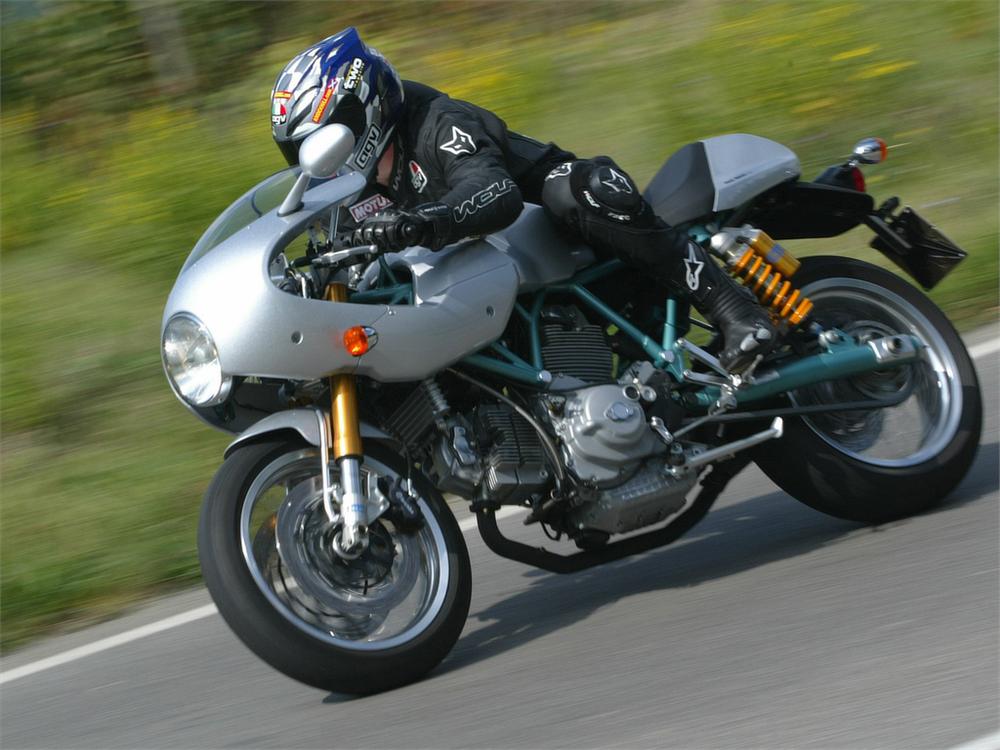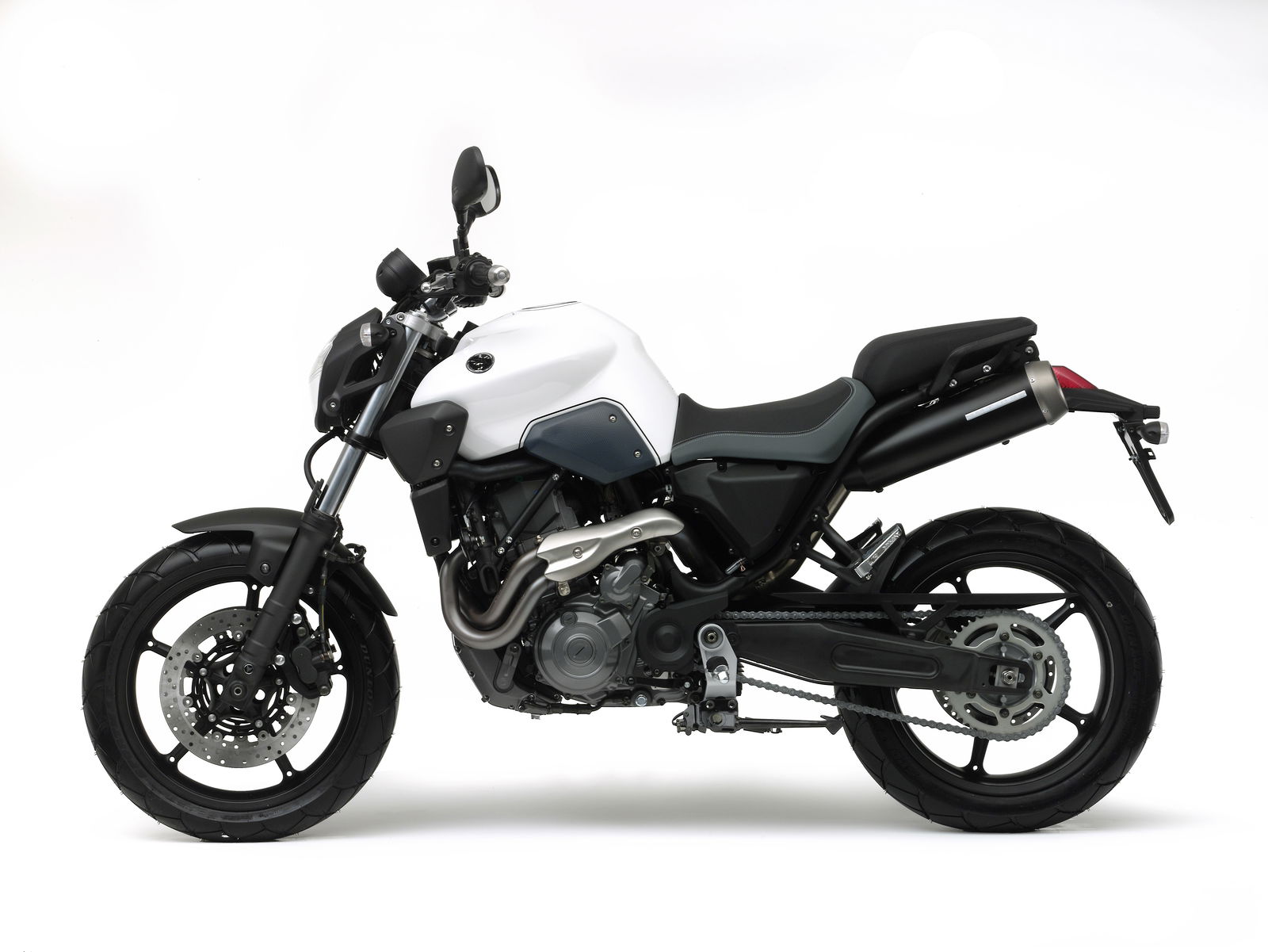SC1000 Sport review
Thirty-three years in the planning and Ducati's Sportclassics are finally here. But you'd better be quick if you want one

APART FROM THE absence of a fairing, the most obvious difference between the Sport and the LE is the unfaired bike's cheaper, less adjustable suspension. Dry weight is down by two kilos to 179kg, no doubt thanks to the lack of fairing. Since both bikes share the same power unit, the Sport's engine and transmission feel virtually identical to the LE's. Once again, gearshifts were mostly slick, however I occasionally found a false neutral between fourth and fifth if my concentration dropped.
This Sport has bar end mirrors which give broad, 'elbow-less' visibility, but you'll need to be careful if you like sneaking between cars when traffic is busy. I lasted about 15 minutes before clipping a Punto.
I also scraped a wall, which didn't upset anyone but would have pissed me off had it been my own bike. The mirrors are a practical styling touch but I reckon as an owner I would find them frustrating.
But the mirrors were a small niggle in the grand scheme of things as I enjoyed a trip back in time, blasting past vineyards lined with ripening fruit. The surroundings may have been pleasant, but the Tuscan roads weren't the best and I had quite a few front-end moments, especially on slower, bumpier corners. The rear shock is fully adjustable but the front forks, angled more steeply than the LE's, are not, so apart from altering tyre pressures you'll have to ride it pretty much as it comes. Despite this, the Sport is a bike that would be at home on any track day, although caution would be necessary on rough circuits because the exhaust tends to kiss the tarmac through big lean right-handers. Brembos do the stopping, with 320mm front discs and a 245mm rear delivering a faultless performance. In 1972 stoppies weren't so popular, but they're achievable now.
Although heavy on the wrists at low speed, the riding position is comfortable, giving good feedback and control. The faster you go the more comfortable it gets, as wind pressure takes the strain.
Being a minimalist myself, the simple analogue clocks worked for me. They also incorporate a digital trip, clock and temperature displays. Of the three colours, I thought the black option was the best, followed by the red, with the 'burnt yellow' being my least favorite. But that's just me.
APART FROM THE absence of a fairing, the most obvious difference between the Sport and the LE is the unfaired bike's cheaper, less adjustable suspension. Dry weight is down by two kilos to 179kg, no doubt thanks to the lack of fairing. Since both bikes share the same power unit, the Sport's engine and transmission feel virtually identical to the LE's. Once again, gearshifts were mostly slick, however I occasionally found a false neutral between fourth and fifth if my concentration dropped.
This Sport has bar end mirrors which give broad, 'elbow-less' visibility, but you'll need to be careful if you like sneaking between cars when traffic is busy. I lasted about 15 minutes before clipping a Punto.
I also scraped a wall, which didn't upset anyone but would have pissed me off had it been my own bike. The mirrors are a practical styling touch but I reckon as an owner I would find them frustrating.
But the mirrors were a small niggle in the grand scheme of things as I enjoyed a trip back in time, blasting past vineyards lined with ripening fruit. The surroundings may have been pleasant, but the Tuscan roads weren't the best and I had quite a few front-end moments, especially on slower, bumpier corners. The rear shock is fully adjustable but the front forks, angled more steeply than the LE's, are not, so apart from altering tyre pressures you'll have to ride it pretty much as it comes. Despite this, the Sport is a bike that would be at home on any track day, although caution would be necessary on rough circuits because the exhaust tends to kiss the tarmac through big lean right-handers. Brembos do the stopping, with 320mm front discs and a 245mm rear delivering a faultless performance. In 1972 stoppies weren't so popular, but they're achievable now.
Although heavy on the wrists at low speed, the riding position is comfortable, giving good feedback and control. The faster you go the more comfortable it gets, as wind pressure takes the strain.
Being a minimalist myself, the simple analogue clocks worked for me. They also incorporate a digital trip, clock and temperature displays. Of the three colours, I thought the black option was the best, followed by the red, with the 'burnt yellow' being my least favorite. But that's just me.
APART FROM THE absence of a fairing, the most obvious difference between the Sport and the LE is the unfaired bike's cheaper, less adjustable suspension. Dry weight is down by two kilos to 179kg, no doubt thanks to the lack of fairing. Since both bikes share the same power unit, the Sport's engine and transmission feel virtually identical to the LE's. Once again, gearshifts were mostly slick, however I occasionally found a false neutral between fourth and fifth if my concentration dropped.
This Sport has bar end mirrors which give broad, 'elbow-less' visibility, but you'll need to be careful if you like sneaking between cars when traffic is busy. I lasted about 15 minutes before clipping a Punto.
I also scraped a wall, which didn't upset anyone but would have pissed me off had it been my own bike. The mirrors are a practical styling touch but I reckon as an owner I would find them frustrating.
But the mirrors were a small niggle in the grand scheme of things as I enjoyed a trip back in time, blasting past vineyards lined with ripening fruit. The surroundings may have been pleasant, but the Tuscan roads weren't the best and I had quite a few front-end moments, especially on slower, bumpier corners. The rear shock is fully adjustable but the front forks, angled more steeply than the LE's, are not, so apart from altering tyre pressures you'll have to ride it pretty much as it comes. Despite this, the Sport is a bike that would be at home on
any track day, although caution would be necessary on rough circuits because the exhaust tends to kiss the tarmac through big lean right-handers. Brembos do the stopping, with 320mm front discs and a 245mm rear delivering a faultless performance. In 1972 stoppies weren't so popular, but they're achievable now.
Although heavy on the wrists at low speed, the riding position is comfortable, giving good feedback and control. The faster you go the more comfortable it gets, as wind pressure takes the strain.
Being a minimalist myself, the simple analogue clocks worked for me. They also incorporate a digital trip, clock and temperature displays. Of the three colours, I thought the black option was the best, followed by the red, with the 'burnt yellow' being my least favorite. But that's just me.

